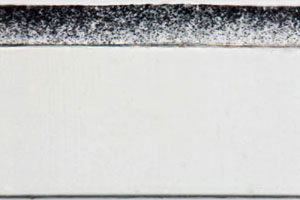Film Decay and How to Slow It
By James Reilly
Director, Image Permanence Institute
Rochester Institute of Technology
 |
|
Black and white film cross section showing that silver particles are suspended in a gelatin binder layer on a plastic support.
|
In a physical sense, film consists of a clear plastic base, a much thinner layer of gelatin emulsion, and an image composed of either color dyes or, in the case of black-and-white film, very small particles of silver.
The goal of preservation is to avoid deterioration in any of these components
The most important thing to do to protect film is to keep it in an environment that is as cold as possible, yet neither too damp nor too dry. Major Hollywood studios and other large film archives have built specially designed, humidity-controlled cold storage vaults to preserve their films. However, understanding the nature of the film decay and taking a few simple precautions can help everyone achieve the longest life possible from their film collection.
